- Origin: Teutonic
- Emblem: Mushrooms, especially fly agaric or fly amanita
- Plant: The presence of galbanum (freula galbaniflua) allegedly invites the protection of gnomes.
- Iconography: The standard garden gnome depicts an older male with a long beard and peaked red hat. He wears a big belt over leggings, a blue tunic, and boots. Sometimes they wear gardeners’ aprons.
The name “gnome” stems from the Greek word “genomos” which means “earth dweller”. They are said to be one of the elemental spirits defined by Paracelsus, as representative of the Earth Element.
Gnomes are subterranean spirits now most associated with garden statuary. They resemble tiny people. Paracelsus described gnomes as two spans high. (A span is the width of an outstretched human hand,) Unlike dwarves or kobolds, gnomes are not mine or cave spirits but tend to live beneath human gardens. They have a reputation for emerging at night to do a little helpful garden work. Garden gnomes allegedly bring luck.
Gnomes tend to be quiet, private, taciturn spirits, but they respond well to gifts and offerings. They can be persuaded to become loyal allies, guardians, and helpers. Female gnomes may be especially taciturn; they are rarely depicted. However folklore indicates that their are entire gnome communities with male and female gnomes of all ages. Gnomes maintain good relationships with birds, rabbits, foxes, hedgehogs, and squirrels.
Originally, gnomes were thought to provide protection, especially of buried treasure and minerals in the ground. Gnomes were regarded as good luck charms by our ancestors and would often be found living in the rafters of barns where they would help watch over livestock. They are still used today.
Garden Gnomes vs “Actual” Gnomes
Modern garden gnomes are based on the legendary “Gnomes” of myth, mysticism, and fairy tales. Gnomes have historically been described as small (from a few inches to a foot or two in height) stout beings who live in Nature – usually underground. European magicians and other mystics considered gnomes the most common and important elemental spirits of the ‘Earth’ element (the other three classical elements being: ‘Water,’ ‘Fire,’ and ‘Air’).
Gnomes were said to wear conical hats and to be able to move through the earth itself as easily as we humans walk upon it, yet if any of these underground dwellers were caught out in the daylight it was said that the rays of the Sun turned them into stone.
Sometimes gnomes were said to have magical powers to protect or punish people – or to reward them with happiness. Gnomes are also said to be guardians of secret underground treasures – especially gold! Even in modern times gnomes are said by some –such as the highly influential mystic Rudolph Steiner – to be involved in the hidden processes of plant life. In fact many farms, including prize-winning wineries, follow principles based on these beliefs.
Garden Gnomes Today
More modern descriptions of gnomes usually emphasize their bright red pointed hats, solid colored clothes, and the long white beard of the typical male. Though sightings of female gnomes are rarely reported, gnome women are generally thought to be beard-free.
The name ‘gnome’ is said to come from the Latin word ‘gnomus’ which is thought to possibly come from the Greek word ‘gnosis’ meaning “knowledge” (i.e. of hidden treasure), but is more likely rooted in the word ‘genomos’ meaning “earth dweller”
A garden gnome adds a bit of whimsy and a connection to the old world, where farmers believed the good luck charm could help their fields yield more produce and protect them from thieves, pests and other problems. They were also thought to help gardeners in the night, which we all could use!
The earliest gnome statuary was produced in Thuringia, Germany, in the early nineteenth century and was based on German folklore. Gnome statues potentially welcome and attract real gnomes, as well as Flower Fairies or other benevolent spirits. The earliest statues were carefully wrought, hand-painted terra-cotta and were exceptionally popular.
By the 1960’s, cheaper plastic and resin versions were mass-produced. The old terra-cotta ones are now extremely valuable and are family heirlooms. Garden gnome statues tend to evoke very visceral responses. Some people adore and collect them. Others loathe them so much that they feel justified destroying or removing other people’s property.
Gnomes are the subject of modern entertainment as well as old folktales. The animated children’s television show The World of David the Gnome was highly unusual in that it depicted both male and female gnomes. The gnomes in J. K. Rowling’s Harry Potter series are garden pests, not helpers.
Some Handy Garden Gnome Trivia:
- Gnomes are banned from the Royal Horticultural Society Chelsea Flower Show. We think that’s a crying shame, personally.
- There are three categories of mass-produced gnomes: Worker gnomes, who always carry tools like fishing rods, shovels, or hammers; at-ease gnomes who typically carry a pipe and cultural gnomes who have a musical instrument in hand. Rock stars.
- Gnomes have a life expectancy of 400 years.
- Their main enemies? Mean humans who destroy the environment and trolls – obviously.
- Male gnomes always wear red caps.
- The world’s oldest garden gnome, called Lampy, has been living at Lamport Hall in the UK for 125 years and is worth a cool £2 million, or €2.4m!
- In the 1980s, the Gnome Liberation Front stole gnomes and sent the owners photos of them from landmarks around the globe.
- Gnomes are generally vegetarian and eat foods like nuts, mushrooms, peas, beans, potatoes, applesauce, fruit, berries, tubers, spices, vegetables, and preserves for dessert.
- They like to drink mead dew made from fermented honey, fermented raspberries, and spiced gin as a nightcap.
- Gnomes kiss by rubbing noses. They also use nose rubbing as a greeting equivalent to human handshaking.
Forest Gnomes:
There are gnomes that live in the forest in the Philippines. You can tell where they live if there’s a hill of dirt that’s a bit higher than everything else. And when you go by them, you’re supposed to be really, really respectful and say:
“Excuse me. I’m just walking by. I don’t mean any harm.”
Even if you’re not doing anything, or no one said anything, or you’re not sure. You’re just supposed to do it. If you don’t, there could be blow back as per the following:
“There was a story on the Philippines news channel, about a kid who had huge swollen lips. You could hardly see his eyes. He was speaking to reporters and he said that he was walking by the hills and his friend told him that you’re supposed to say sorry and he said, “No, I’m not. I don’t care. I don’t believe in that stuff.”
Then the next day he woke up with a tumor on his face. Not so much as a tumor, but as his lips were super swollen. It looked like someone blasted air into his lips. Like super Botox.”
Walking Gnomes
The following story is very interesting in the fact that this is one of the few stories from Mexico where inanimate objects, that are not haunted, come to life. The Mexican culture does not traditionally include creatures such as gnomes but instead, it consist of larger creatures and ghosts. This is because the country did not originally have gnomes until places, such as the United States introduced them to there.
“In Mexico they believe that garden gnomes come alive at night. The proof they have of it is that my grandma used to own gnomes and her neighbors used to own gnomes in Mexico. And the garden gnomes the next day would be found in different places and a lot of stuff was broken and sometimes my mom and her sister would wake up at night, and they would hear things, but when they looked outside, they would never see the gnomes there. So there’s that story that they become alive at night in Mexico.”
“Recently I was talking to one of my cousins who told that story to some friends whose parents were also from Mexico. And this friend told my cousin that he actually believes that story, because one night the garden gnomes were not where they had placed them. They found them inside the house one night in the house and they were rolling in the hallway. Since then, they got rid of the gnomes, or at least they tried to. They threw them away but the next day they were in the same place they had put them before.”
The Secret Lives of Garden Gnomes
From Neopets.com, here’s a story about what Gnomes do at night. I’m pretty sure this is a made up story, but I thought it was fun, and who knows? Maybe it isn’t altogether fictional. You be the judge:
The reason Garden Gnomes come alive at night is because they don’t want anyone to see them moving around. This is pretty practical, considering the fact that if any regular person saw them talking and moving, they’d want to put them in some sort of abnormality museum!
But what do garden gnomes do at night? Well, I was watching out my window at the gnomes in my garden one night, and I saw one, a Bruce gnome, have them all line up in a row as he paced back and forth in front of them, a small twig in his hand like he was the instructor of a military camp.
He was telling each gnome which direction to go in order to pick up free food. You see, garden gnomes thrive like ants. They all go off to find food that people may have dropped accidentally or on purpose, and sometimes they even venture into houses and borrow food with no intention of returning (also known as stealing, but they take such small portions most people never even notice).
After retrieving food they rush back to their home center (which is usually a tunnel in the ground leading into a large, dug out room, since gnomes are not claustrophobic) and report to the leader, in this case the Bruce gnome. He then tallies their lot and tosses the foot morsel into another room in their tunnel, where they store their food. They act sort of like chipmunks, storing food and hunting for it, of course, gnomes are not carnivores though.
And, to their enormous pleasure, when they have collected a lot of food, they sit down at have a feast! Yes, a feast! It’s a feast of little sweets, candy peas, popcorn pieces, and sometimes even whole flower cakes (although they take more than one gnome to carry). But besides eating, what else do gnomes do? Well, I’m glad you asked.
You wouldn’t suspect this, but when they have leisure time, gnomes enjoy swimming. They are very pleased to find a Neogarden where someone owns a pond. They jump right in, clothes and all, and swim and dive around in the cool water for hours at a time. And when they want to dry off, they take a large leaf and wrap themselves up in it, drying off quickly.
Aside from swimming, gnomes also enjoy crafts. They may take green blades of grass and weave adorable little baskets or even blankets. They can also take pieces of bark off of trees and sticks and carve them with sharp stones into little sculptures. Gnomes are very talented in the artistic field, and if you see a stick carved into a Meepit, you know who did it.
Aside from swimming and crafts, another thing gnomes enjoy is sports. They might play their own version of soccer by kicking around a rounded stone, or even play basketball by throwing a rock into a hole. This not only provides exercise, but gives them lots of time together to just have fun.
But when they aren’t playing and having fun, what do they do? Throughout the whole day, they sleep, and at night they either have fun or look for food, so there’s only a little bit of time left for something else-note-taking! This is sort of like their education, which is actually an education of…what else? Neopets!
Note-taking is when gnomes grab their oversized pencils and paper, which they “borrow” from Neopets, then marching through the sleeping pet’s house and going to their bedroom, where they climb up on the bed and observe the neopet’s sleeping habits. They are trying to find out where Neopets came from. Maybe all Neopets evolved from Myncis! 😛
Another sort of educational activity that gnomes practice is counting. It isn’t counting like 1, 2, 3, 4, 5, 6, 7, 8, though, no, no no! It’s counting in a different way. The gnomes version of counting may be why your plushies eye was missing when you woke up.
Gnomes will trample in when you are catching some Z’s (it seems all of their educational activities are while Neopets are slumbering) and then they will be assigned a number (by there leader, the Bruce gnome) and then they shall go “counting” which, in other words, is another type of stealing. They have to pick up ten, for example (or however many their number is) trinkets, like plushie eyes, toothpicks, or buttons, and bring them back to their tunnel, storing them in a safe place. What they do with them I do not know, but I suspect they might make furniture or something of the sort using what they found.
One last thing I found out is that gnomes are a fan of bright colors and patterns. In the early morning, I saw them getting ready for bed and they were wearing long pants and long sleeved shirt PJ’s of hot pink, bright purple, lime green, and sunny yellow color. Some had stripes, some had polka dots, and some even had swirlies! Gnomes are very interesting, no?
Now you know what gnomes do when you aren’t looking, what their secret life is all about. If you look out your window at night, you might be able to see them moving and hear them talking in their high pitched voices. But be warned-if they see you watching them, well, I won’t go there…
Sources:
- House and Garden
- Encyclopedia of Spirits
- Love To Know
- Folklore USC
- Just Say Gnome
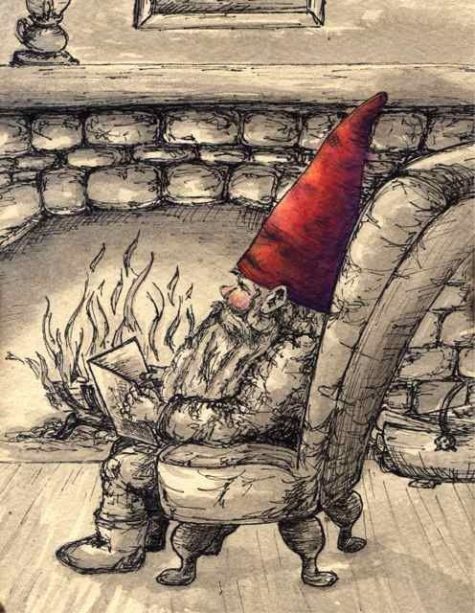
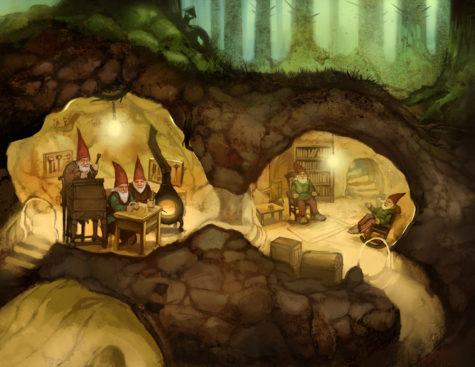
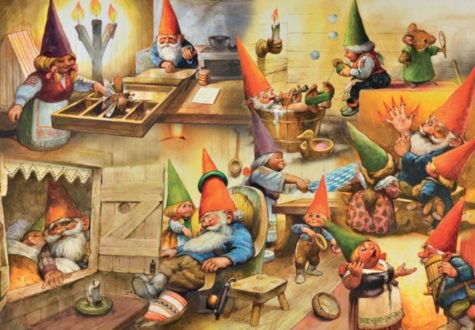
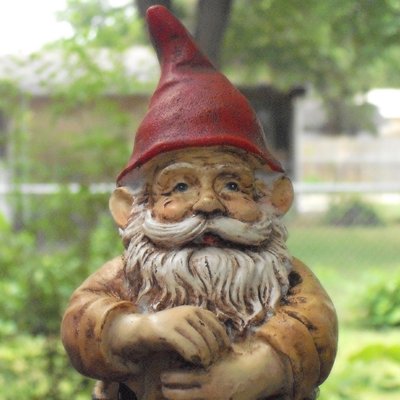
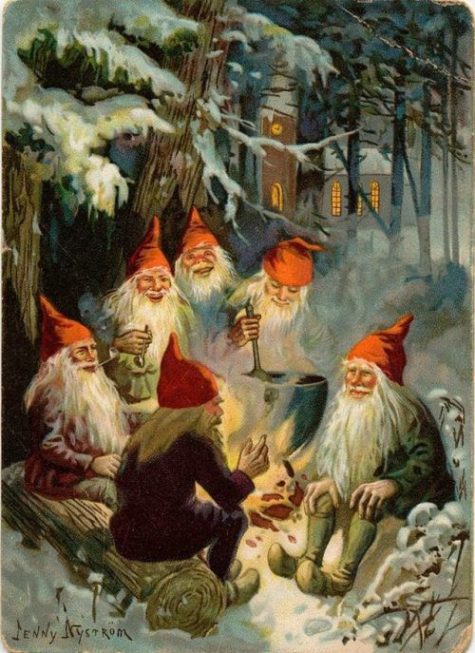
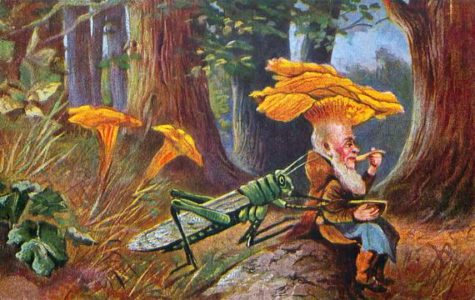
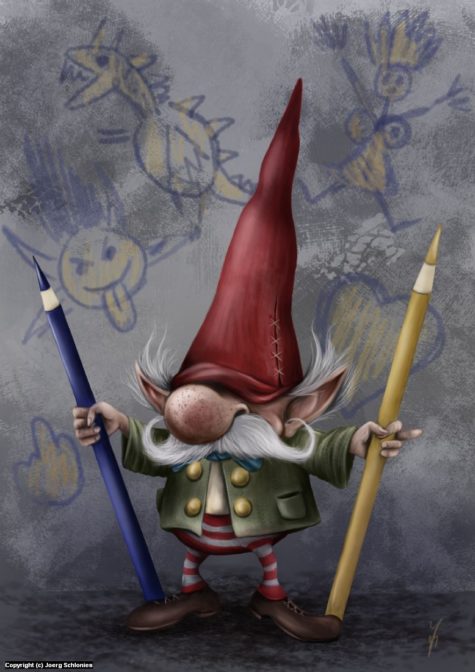




Leave a Reply